What can digital twins bring to wireless communication?

Twin means twins (identical eggs). Since the two share the exact same genes, they are connected in spirit, are allergic to the same food, and have the same chance of suffering from the same disease, so the treatment plan for one can be directly copied to the other.
The so-called digital twin is to create a "digital clone" on a computer system for real things. Although one is real and the other is virtual, they operate in exactly the same way. Therefore, the ontology can synchronize its own state to the digital clone in real time, and the digital clone can also use advanced tools such as big data and artificial intelligence. The best decision-making plan is issued to Ontology for execution.
A digital twin is essentially a tool for solving complex system problems. Its value is to build the digital clone as a test bed of the ontology, which is used for continuous technical verification, optimization, trial and error in the digital world; while the ontology of the real world remains stable, and the results of the digital clone are taken when necessary. Come and use it. In this way, risks can naturally be reduced, costs can be saved, and efficiency can be improved.
Digital twins originated in the aerospace and military industry, and continue to expand to vertical industries such as smart manufacturing and smart cities. With Gartner listing digital twins as one of the top ten strategic technology trends of the year (2017-2019) for three consecutive years, the communications industry has also begun to study the application of digital twins.
For the origin of digital twins, you can refer to this article in the previous issue: "Digital twins, actually originated from a disaster that almost happened? ".
Why does the communications industry need a digital twin?
Students who often conduct wireless network testing, operation and maintenance, and optimization may have a deep understanding of the following two words: "walking on thin ice, like facing the abyss".
The mobile communication network belongs to the infrastructure, and the services such as calling and surfing the Internet are also rigid needs that cannot be separated for a moment. Once the operation error leads to a large area, long-term network disconnection or performance deterioration, it is tantamount to a major accident.
Therefore, all operators are cautious about any operation on the "existing network". For example, for new function testing, it is generally necessary to strictly select and limit the area, and repeatedly confirm and modify the parameters. The operation and implementation should be carried out in the early morning when everyone is sleeping, for fear of problems affecting users.
The communication system is an extremely complex and huge system. The end-to-end network includes various network elements, and each network element has a variety of different jobs and different concerns.
We are like a blind man touching an elephant. We can only see the forest without seeing the forest. We are difficult to control the overall situation. We are slow to respond to changes in user needs. We lack tools to accurately predict network performance. We can only walk slowly and tentatively.
The so-called "a wise man has a thousand thoughts, and he must make a mistake". No matter how "well-planned" we devise strategies, it is difficult to win a thousand miles smoothly, and there will always be various unexpected problems during execution.
If we can have a system, we can not only fully verify the validity of the parameter combination before deployment, but also find the optimal parameters through intelligent optimization. The so-called "behind the door, go out and follow the same path" is such a state.
To design this system, the industry turned to a new digital concept:
Yes, that is: a digital twin.
How does the communications industry apply digital twins?
Communication networks have unique advantages in building a "digital twin" system.
First, each base station in the network actually has an accurate model in the network management system. It not only includes engineering parameters such as site location, longitude and latitude, antenna height, azimuth angle, and pitch angle, but also includes many functional characteristics, thousands of wireless parameters that shape network performance, and ground planes that work together with other network elements. Parameters, etc., these data can already build a digital base station.
Then, in the core network, all the data of each user is stored, and we know where each user is, what package they use, what APP they like to use, what mobile phone they have, and who to call when and so on. Generally speaking, operators manage this data very strictly and don't have to worry about being peeped.
Third, as long as your mobile phone has a signal, it is constantly interacting with the network. In addition to the actual data sent, there are also signaling for system control, detection of wireless signals in various frequency bands, and reporting of the signals measured by yourself. Quality, and so on. The base station is even more busy. In addition to providing services for mobile phones, it also aggregates all the information collected into performance KPIs to judge how your user experience is. In other words, the entire system has a comprehensive grasp of the content and flow of information.
It can be seen that the current communication network has built a very complete software system on top of proprietary hardware, and has such detailed data that can be interactively updated in real time. On this basis, with appropriate simplifications and trade-offs, we can build a virtual, high-precision digital twin system on a general-purpose server.
The first thing we need to do is to build a fully virtualized twin system end-to-end on the basis of the general server.
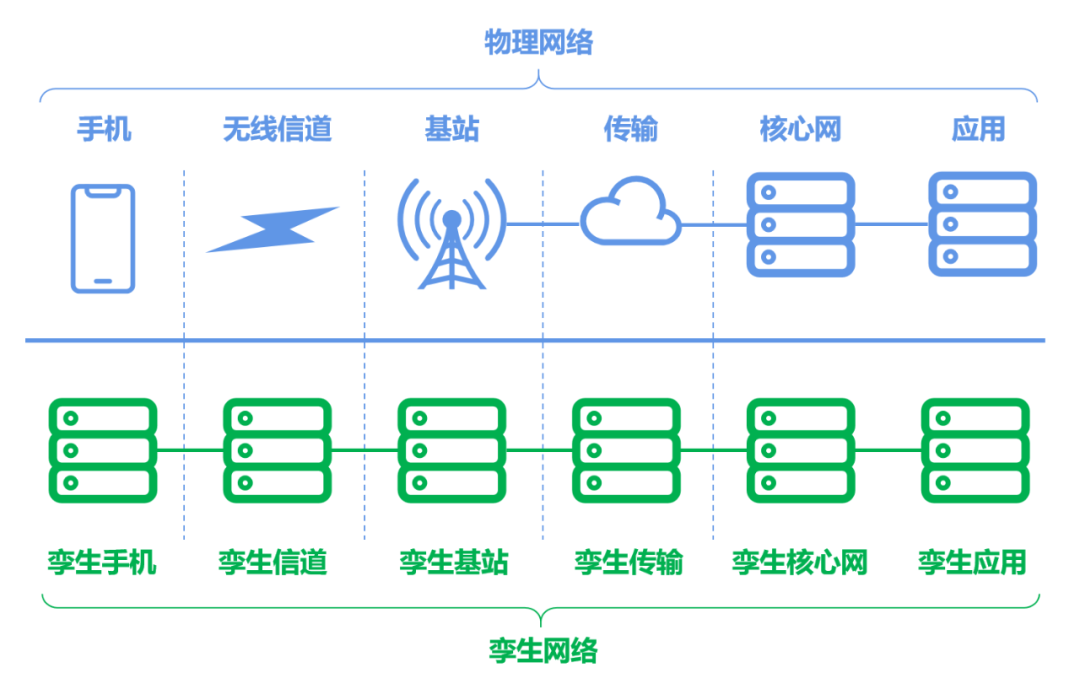
Twin mobile phones: Simulate multiple mobile phones with different capabilities on one server, and can be configured to randomly perform different behaviors to simulate real users. For example, x% of mobile phones watch video, y% of mobile phones play games, z% of mobile phones move at high speed... These virtual mobile phones do not need to actually transmit signals because they are connected to virtual wireless channels.
Twin wireless channel: It is necessary to simulate the reflection, scattering, diffraction and fading of wireless signal propagation based on the high-precision map and the environmental information of the mobile phone, and to simulate the reflection, scattering, diffraction and fading of the wireless signal through the ray tracing model. The interference below can also be simulated, which can be said to be very comprehensive.
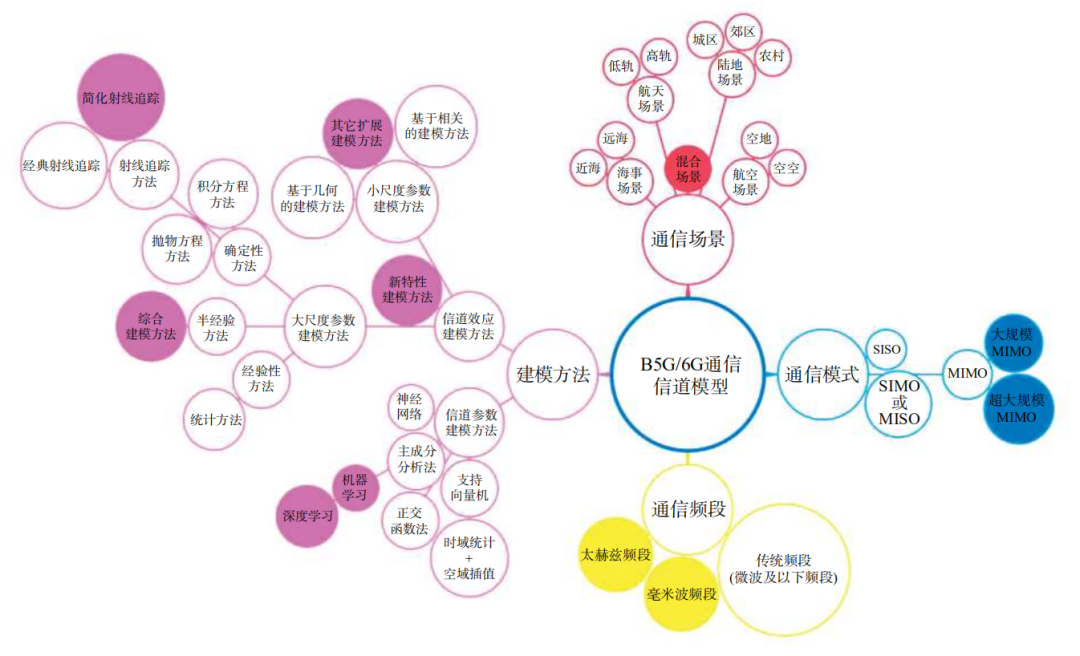
Knowledge Graph of Digital Twin Channel Modeling Methods for B5G and 6G Communications, Source: Research on Digital Twin Channels for B5G and 6G Communications
Twin base station: a base station that is completely simulated by a server. The details include all the software and hardware modules of the physical base station. The software algorithm of the above operation is exactly the same as that of the real base station. The only difference is that the base station does not need to actually transmit signals. The above virtual wireless channel.
Twin core network: At present, the commercial core network has been fully virtualized. It only needs to be taken directly, and then some simplification and adaptation can be used.
This end-to-end virtual twin system can simulate the real base station with 1:1 fidelity after loading the same software algorithm as the physical mobile phone, base station and core network, and configuring the same parameters. For a business, the result of running in the twin system is consistent with the effect of the real base station.
For example, this twin system can accurately predict network performance: suppose you are watching a video on your phone in People's Square, while your virtual phone is watching the same video in the virtual People's Square, the video on your real phone and the virtual phone Clarity and smoothness are exactly the same.
It is not enough to have the most basic twin system. We also need to construct an intelligent and automated network application layer on it to solve practical problems in the physical network, including end-to-end network SLA quality assurance, precise network optimization, large-scale Scale antenna weight optimization, user experience improvement, etc.
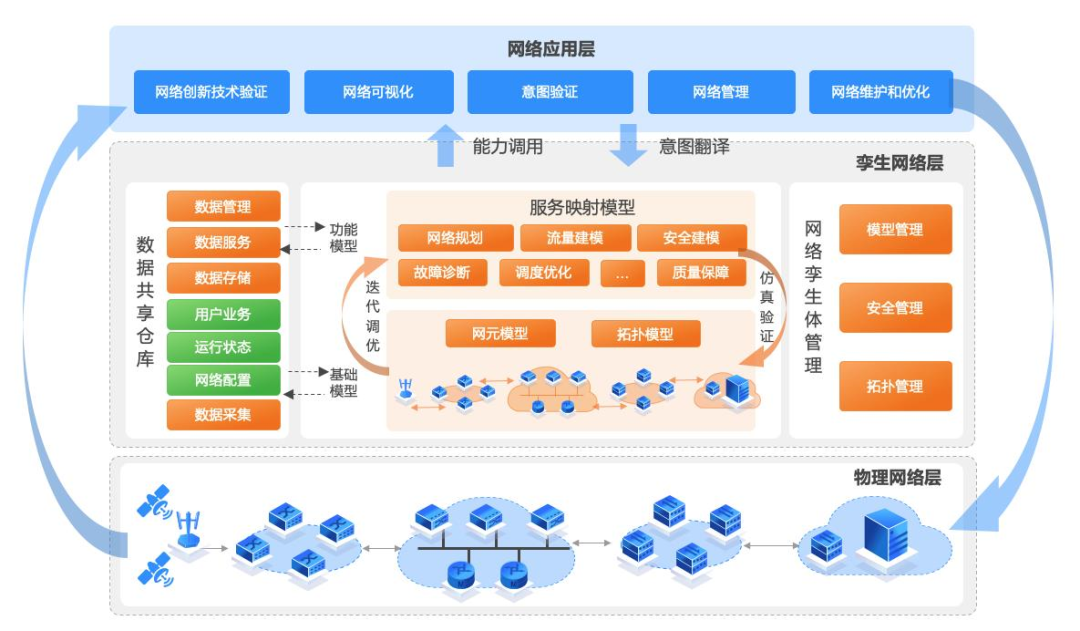
Digital Twin Network Structure, Source: Digital Twin Network (DTN) White Paper
As shown in the figure above, the data flow between the network application layer, the twin network layer and the physical network layer constitutes a large loop, which we call the "outer loop"; inside the twin network layer, there will also be a continuous iterative tuning process and the "inner loop" verified by simulation.
The solutions to these problems are generally as follows:
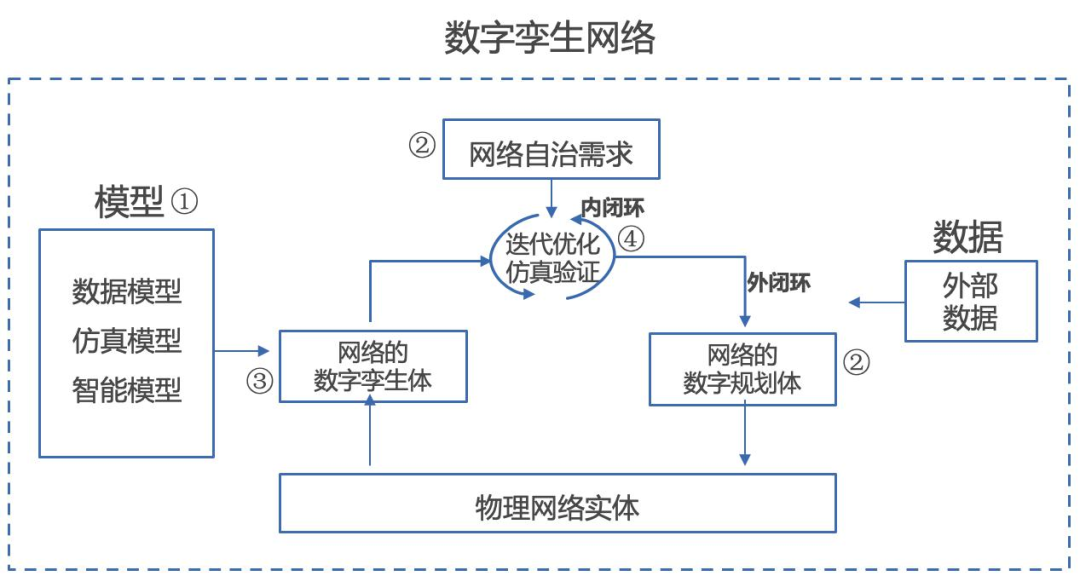
The operation process of digital twin network, source: 6G wireless network autonomy white paper based on digital twin network
First, the system builds a digital twin based on physical network entities; the operation and maintenance personnel issue intentions, and the system translates them into network autonomy requirements through the intention network; the digital twin is demand-oriented, and the internal self-iteration optimization and simulation verification are continuously carried out until The performance of the twin network achieves the expected goal; then the digital twin network generates a "digital planning body", and uses it to synchronize the optimized data to the physical network entity, which is the "inner loop".
After the physical network runs with new data, it is found that there is still a gap between the results and the target, so the results are fed back to the digital twin for continued optimization, which is the "outer closed loop". These two closed loops continue to operate in this way, driving the performance of the physical network to achieve the desired goals.
Next, we take network rate optimization as an example to illustrate the role of the digital twin network in it.
At present, we mainly face the following problems when optimizing the wireless rate:
- Deterioration of user perception is currently mainly detected passively through user complaints or alarms, and then through the dispatch of work orders,
After the process of problem location and resolution, it will seriously affect the user's perception and satisfaction;
- The complexity of the wireless network itself leads to too many factors affecting the rate, and at the same time it is impossible to determine the
the actual scope of influence of different factors in the external or internal environment;
- When optimizing wireless networks, we cannot predict the impact on existing network services caused by adjusting different influencing factors.
Whether the impact is large or small, positive or negative;
- After the actual parameter adjustment, our test verification is often insufficient, and it is easy to miss the verification of other scenarios that are not related to this operation, which will affect the business and waste a lot of manpower and material resources.
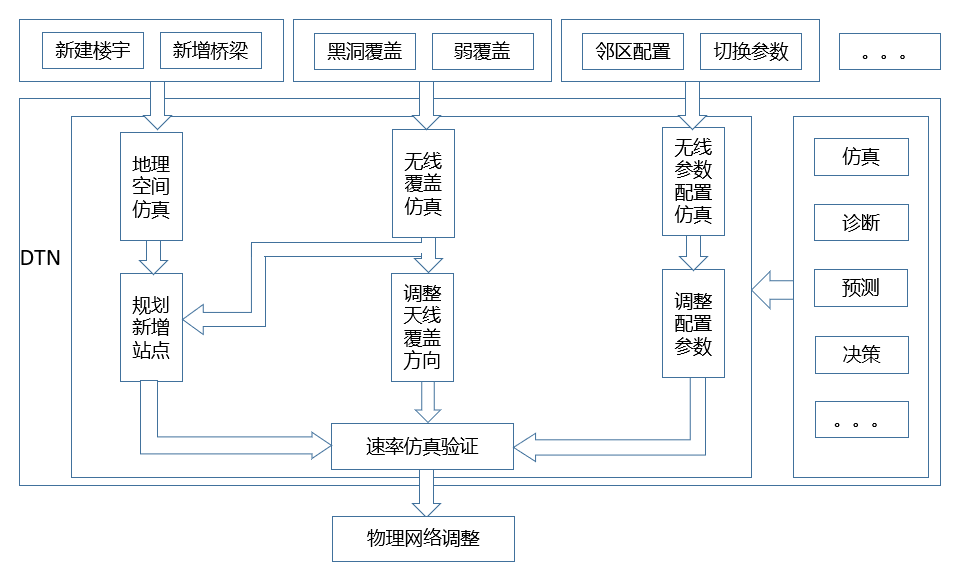
Schematic diagram of wireless rate optimization based on digital twin network, source: Digital Twin Network (DTN) white paper
With the digital twin network, geospatial simulation, wireless coverage simulation, and wireless parameter configuration simulation can be automatically performed, user perception problems can be detected in time, and site addition, coverage optimization, and parameter optimization can be performed in the twin network according to the simulation results. And perform iterative verification of the network rate; finally, the optimized solution will be output to the physical network for execution.
Of course, some operations need to be performed manually, such as site creation and antenna coverage direction adjustment. These manual operations are superimposed on the parts that are automatically performed by the physical network, and finally the goal of network speed optimization is achieved.
Outlook for the future
In 5G and previous communication systems, the various stages of the life cycle such as network planning, construction, operation and maintenance, and optimization are separated from each other, resulting in low efficiency and high costs. The self-intellectual network is proposed to solve these problems. Digital twin is an important way to realize self-intelligence network. At present, the industry has carried out extensive research.
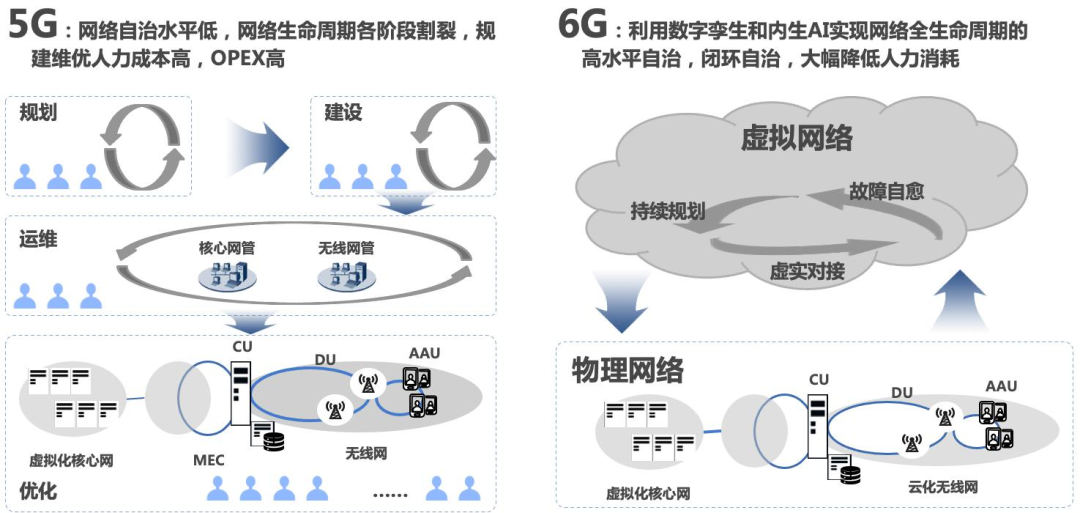
Comparison of 5G network operation and maintenance management and 6G digital twin network autonomy, source: 6G wireless network autonomy white paper based on digital twin network
At present, the application of digital twins in communication networks is still in the early research stage, and the industry has not yet formed a consensus on the concept and connotation of digital twin networks. Moreover, as a complex system based on a large-scale communication network, the digital twin network has many technical difficulties that need to be overcome in terms of data, model and architecture.
The industry's current exploration of digital twins on 5G networks is still plug-in and fragmented. "Plug-in" means that the digital twin network and physical network are separated in hardware and software and have not been integrated, which limits the real-time and effectiveness of data synchronization and distribution; "fragmentation" means A high degree of automation is achieved for some specific functions in a use-case-driven way, but the systemic and universality is not enough.
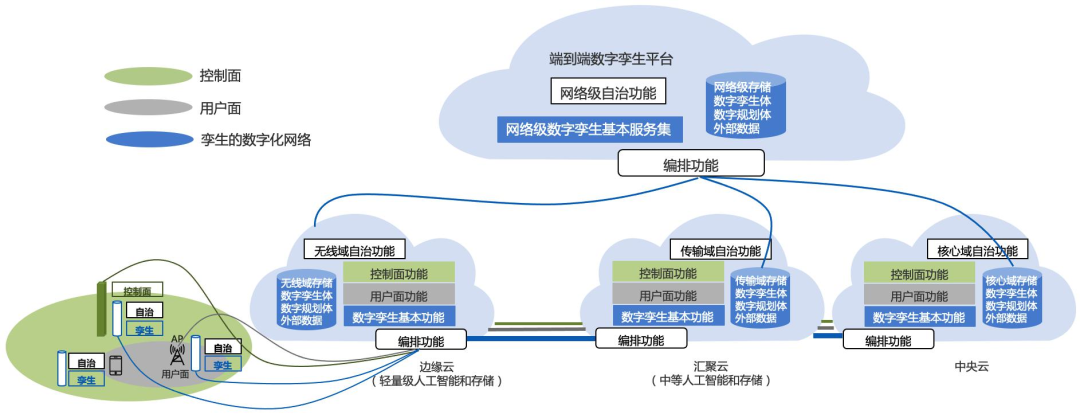
Schematic diagram of the end-to-end architecture of the digital twin network, source: White Paper on 6G Wireless Network Autonomy Based on Digital Twin Network
In the 6G era, we expect to use the endogenous computing power and endogenous intelligence of the network to build a digital twin network, and perform virtual-real connection, continuous planning, and self-healing of faults on it, so as to achieve high-level autonomy and closed-loop autonomy for the entire life cycle of the network. , reduce labor consumption and greatly improve network operation efficiency.
A thousand miles begins with a single step. The seed of digital twin, under the dedication of colleagues in the industry, will surely bloom in the 6G era.